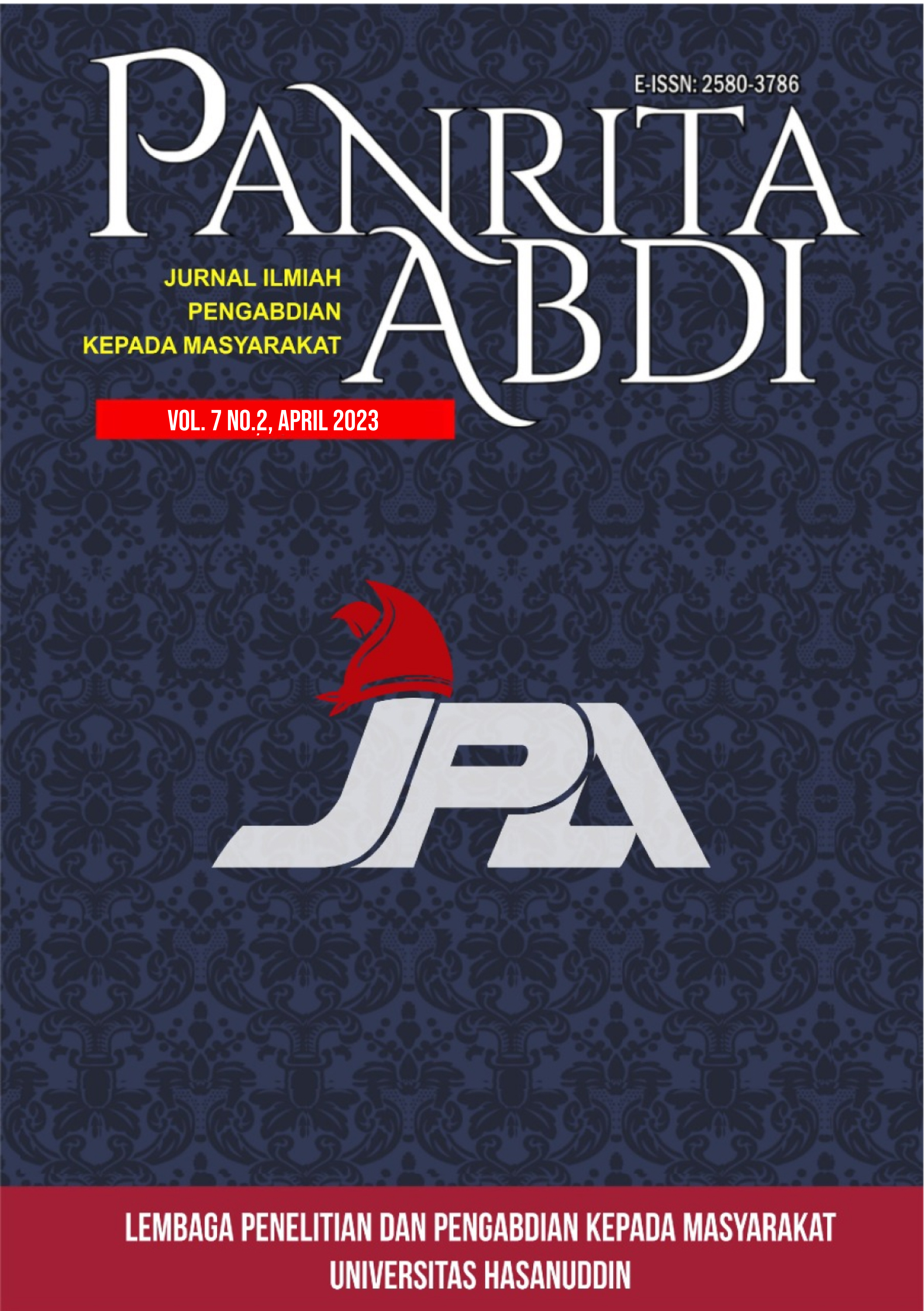PELATIHAN MUSCLE EXTENSION STRENGTH EXERCISE SEBAGAI UPAYA PENCEGAHAN PENYAKIT HNP MASYARAKAT LANSIA DI KELURAHAN KARANGAYU KOTA SEMARANG
DOI:
https://doi.org/10.20956/pa.v7i2.21720Keywords:
HNP, muscle extension strength exercise, elderly, physiotherapy, home programmingAbstract
There are many disease conditions that we most often encounter in the presence of a disorder in the back area or commonly referred to as the Scientific Language of Medicine and Health, namely the Hernia Nucleus Pulposus (HNP), which is a condition in which there is a protrusion of the disc towards the posterior or posterolateral direction caused by suppression by the annular fibrosis. Muscle extension strength exercise increases muscle strength, maintains posture, and prevents excessive movement of the spine in the lumbar area. Physiotherapy plays an active role in providing home programming exercises to elderly community participants to prevent chronic pain and the occurrence of HNP. The purpose of this community service is to prevent HNP disease. The method carried out is presenting material about HNP, question and answer discussion sessions, examination and measurement, and workout. This community service activity was conducted on Saturday, October 23, 2021, at the Karangayu Village Office, Semarang City. The number of elderly community participants who attended the muscle extension strength exercise training activity was 30 participants. Furthermore, the monitoring and evaluation data collection process activities are carried out every month for two months, which is carried out every Saturday, October 27, and November 13, 2021. The monitoring and evaluation activity data results were obtained from as many as 22 participants who implemented the training. The results of the analysis showed that the odd ratio obtained was 0.36. The conclusion is that the elderly community in Karangayu Village, Semarang City, is running well and smoothly, but the short duration provides suboptimal data. --- Banyak nya suatu kondisi penyakit yang paling sering kita jumpai di adanya suatu gangguan pada daerah punggung belakang atau biasa disebut dengan Bahasa Ilmiah Kedokteran dan Kesehatan yaitu Hernia Nucleus Pulposus (HNP) yang dimana suatu keadaan di mana terjadi penonjolan diskus ke arah posterior atau postero lateral yang disebabkan adanya penekanan oleh fibrosus annulus. Muscle extension strength exercise berfungsi untuk meningkatkan kekuatan otot dan mempertahankan postur serta mencegah gerakan berlebihan tulang belakang pada area lumbar. Fisioterapi berperan aktif untuk memberikan latihan home programming pada peserta masyarakat lansia untuk mencegah nyeri kronik dan terjadi nya HNP. Tujuan dari pengabdian masyarakat ini adalah untuk pencegahan penyakit HNP. Metode yang dilakukan adalah pemaparan materi tentang HNP, sesi diskusi tanya dan jawab, pemeriksaan dan pengukuran serta workout. Kegiatan pengabdian kepada masyarakat ini dilakukan pada hari Sabtu, 23 Oktober 2021 berlokasi di Kantor Kelurahan Karangayu Kota Semarang. Jumlah peserta masyarakat lansia yang hadir dalam kegiatan pelatihan muscle extension strength exercise sebanyak 30 peserta. Selanjutnya, kegiatan proses pengambilan data monitoring dan evaluasi dilakukan setiap 1 bulan sekali selama 2 bulan yang dilakukan setiap hari Sabtu, 27 Oktober dan 13 November 2021. Hasil data kegiatan monitoring dan evaluasi diperoleh sebanyak 22 peserta yang menerapkan pelatihan tersebut. Hasil analisis menunjukkan bahwa odd ratio yang didapat sebesar 0,36. Kesimpulan nya adalah masyarakat lansia di Kelurahan Karangayu Kota Semarang berjalan dengan baik dan lancar, namun durasi yang singkat memberikan data yang kurang optimal.
References
Stepvia. (2019). Analisis aktivitas harian pada penderita hernia nucleus pulposus. Researchgate.
Vos, T., Flaxman, A.D., Naghavi, M. (2010). Years Lived with Disability (YLDs) for 1160 Sequelae of 289 Diseases and Injuries 1990-2010: A Systematic Analysis for The Global Burden of Disease Study 2010. Lancet, 2168.
Price, S.A., & Wilson L.M.C. (2012). Patofisiologi Konsep Klinis Proses – Proses Penyakit. Jakarta : EGC. Hal. 6(1): 964 – 972.
Park, S.Y., Lim, D.C., & Jeon, K.K. (2011). Effects of exercise pattern on lumbar extension strength and balance in chronic low back pain patients. Korean J Exerc Rehabil; 7: 227–237.
Park S.Y., Noh, S.Y., & Jeon, K.K. (2011). The effect of lumbar stabilization exercise on extension strength and visual analogue scale in patents with herniated intervertebral disc. Korean J Sports Sci; 20: 1237–1246.
Choi, G., Raiturker, P.P., & Kim, M.J., (2005). The effect of early isolated lumbar extension exercise program for patients with herniated disc undergoing lumbar discectomy. Neurosurgery; 57: 764–772.
Peng, B.G. (2013). Pathophysiology, diagnosis and treatment of discogenic low back pain. World J Orthop; 4: 42-52.
Hadjipavlou, A.G., Tzermiadianos, M.N., Bogduk. N., & Zindrick, M.R. (2008). The pathophysiology of disc degeneration: a critical review. J Bone Joint Surg Br; 10:1261-1270.
Riskesdas. (2013). Riset Kesehatan Dasar. Jakarta: Badan Penelitian dan Pengembangan Kesehatan Kementrian Kesehatan RI.
Nasikhatussoraya, Octaviani & Julianti. (2016). Hubungan intensitas nyeri dan disabilitas aktivitas sehari-hari dengan kualitas hidup : studi pada pasien Hernia Nukleus Pulposus (HNP) Lumbal. Jurnal Kedokteran Diponegoro : 5,4:1364-1377.
Setiyowati, Y.D., & Ompusunggu, N. (2022). Pendidikan kesehatan masyarakat melalui kegiatan penyuluhan mengenai hernia nuklues pulposus di komplek YON ARHUNUDRI PAKULONAN, JAKARTA.Jurnal Kreativitas Pengabdian Kepada Masyarakat Universitas Malahayati: 5,9.
Parker S.L., Mendenhall, S.K., & Godil, S.S. (2015). Incidence of low back pain after lumbar discectomy for herniated disc and its effect on patient-reported outcomes. Clin Orthop Relat Res; 473: 1988–1999.
Prasad, M.H., Dhakal, M., Singh, K., Srivastava, A., & Sharma, V. (2005). Epidemiological Characteristics Of Lumbar Disc Prolapse In A Tertiary CareHospital. The Internet Journal of Neurosurgery; 3(1): 1-4.
Downloads
Published
How to Cite
Issue
Section
License
Copyright (c) 2023 Ashifa Quamila, Daniel Saka Pratama, Elsa Kurnia Sari, Endang Sulastri

This work is licensed under a Creative Commons Attribution-NonCommercial-NoDerivatives 4.0 International License.











